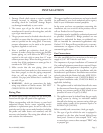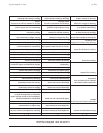
Part # 1844063 (08/06)Page 10
good mixture of air and gas. When using LP gas the
flame will have a blue yellow appearance. Follow steps
thru to adjust the flame for good quality.
1. Loosen the small knurled locking disk.
2. Turn the large adjusting disk towards the air mixture
throat to reduce the opening. is restricts the
amount of air, causing the flame to turn yellow.
3. Turn the adjusting disk gradually out, away from
the air mixer throat, allowing more air into the air
mixer until the yellow disappears and a sharp blue
flame appears.
4. When the flame turns blue and spreads out, turn
the locking disk tight against the adjusting disk.
ere may be intermittent yellow-orange flame
noticed. is is caused by dust particles burning in
the Flame. Should the burners fail to light, check
to see if there is a problem with any or all of the
following.
A. e gas supply: If there are other gas appliances on
the same supply line, shut them off temporarily and
see if the flame comes back on, or if it fluctuates as
other gas appliances are turned on and off. If so, it
would indicate overloading of the gas supply or a
faulty gas pressure regulator. You should contact a
qualified service agency or the local gas company to
check the gas supply.
B. Dirty burner orifice or ports: With the oven cold,
use a thin wire to check that the spud orifice (nozzle)
is clear. If necessary, loosen and remove the spud.
Be careful when cleaning not to enlarge the hole.
en, using a wire or thin nail, clear the burner
ports of carbon deposits or other restrictions.
Periodically, after breaking the ovens in, check the burner
flame and readjust the air mixture if needed. Black soot
on the oven doors or in the burner compartment may
indicate that not enough air is mixing with the gas. If
this case back off the air adjustment disk until the proper
flame and color is set.
By-Pass Flame Adjustment
e by-pass in the thermostat is a small gas supply
through the control that is independent of the dial
setting. It is controlled strictly by the Adjusting Screw.
is small gas supply maintains a minimum flame or
the burner(s), helping to maintain the heat in the oven
and assisting in recovery. is adjustment is best done
when the oven is being heated for the day’s business. To
adjust the by-pass flame follow steps thru .
1. Turn the oven on and set the thermostat to the
desired temperature.
2. Allow the oven to pre-heat until the burner flame
begins to throttle down.
3. At this point, turn the thermostat dial all the way
down. is ensures that the thermostat is in the by-
pass mode. ere should now be a small steady flame
remaining across the burner without flickering or
going out.
NOTE: It may be necessary to turn the thermostat back
up to relight the burner(s) if there is not flame present.
4. Using a small screwdriver, reach through the access
hold on the control panel to the left of the thermostat
knob. Turn the by-pass adjustment screw to raise
or lower the by-pass flame as required. Counter-
clockwise raises the flame, clockwise lowers the
flame. Take care not to turn the screw out too far
as that will allow gas to leak around the adjustment
screw.
Calibration
1. Field calibration is seldom necessary and should not
be attempted unless experience with cooking results
definitely proves that the control is not maintaining
the temperature to which the dial is set.
2. Place the thermocouple of the test instrument
or reliable mercury thermometer in the center
of the oven approximately one or two inches
(25mm – 50mm) above the hearth. Do not place the
thermocouple directly in contact with the hearth.
ADJUSTMENTS Continued


















